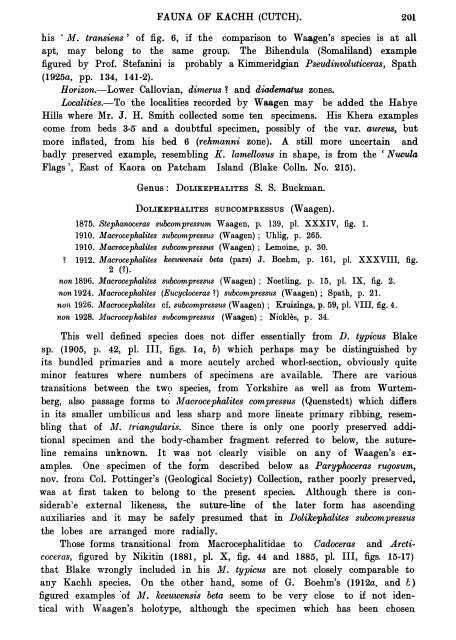ialontolngia ndita,
ialontolngia ndita,
ialontolngia ndita,
Create successful ePaper yourself
Turn your PDF publications into a flip-book with our unique Google optimized e-Paper software.
FAUNA OF K.ACHH (CUTCH). 201<br />
his '.1l'1. transiens ' of fig. 6, if the comparison to Waagen's species is at all<br />
apt, may belong to the same group. The Bihendula (Somaliland) example<br />
figured by Prof. Stefanini is probably a Kimmeridgian Pseudinvoluticeras, Spath<br />
(1925a, pp. 134, 141-2).<br />
Horizon.-Lower Callovian, dimerus and diadematus zones.<br />
Localities.-To the localities recorded by Waagen may be added the Habye<br />
Hills where Mr. J. H. Smith collected some ten specimens. His Khera examples<br />
come from beds 3-5' and a doubtful specimen, possibly of the var. aureus, but<br />
more inflated, from his bed 6 (rehmanni zone). A still more uncertain and<br />
badly preserved example, resembling K. lamellosus in shape, is from the 'Nucula<br />
Flags ', East of Kaora on Patcham Island (Blake Colln. No. 215).<br />
Genus :<br />
DoLIKEPHALITES S. S. Buckman.<br />
DoLIKEPHALITES SUBCOMPRESSUS (W aagen).<br />
1875. Stephanoceras subcompressum Waagen, p. 139, pi. XXXIV, fig. 1.<br />
1910. Macrocephalites subcompressus (Waagen) ; Uhlig, p. 265.<br />
1910. Macrocephalites subcompressus (Waagen) ; Lemoine, p. 30.<br />
1912. Macrocephalites keeuwensis beta (pars) J. Boehm, p. 161, pi. XXXVIII, fig.<br />
2 (?).<br />
non 1896. Macrocephalites subcompressus (Waagen) ; Noetling, p. 15, pi. IX, fig. 2.<br />
non 1924. Macrocephalites (Eucycloceras ) subcompressus (Waagen) ; Spath, p. 21.<br />
non 1926. Macrocephalites cf. subcompressus (Waagen) ; Kruizinga, p. 59, pi. VTII, fig. 4.<br />
non 1928. Macrocephalites subcompressus (Waa.gen) ; Nickles, p. 34.<br />
This well defined species does not differ essentially from D. typicus Blake<br />
sp. {1905, p. 42, pl. Ill, figs. la, b) which perhaps may be distinguished by<br />
its bundled primaries and a more acutely arched whorl-section, obviously quite<br />
minor features where numbers of specimens are available. There are various<br />
trnsitions between the two species, from Yorkshire as well as from Wurtemberg,<br />
also passage forms to Macrocephalites compressus (Quenstedt) which differs<br />
in its smaller umbilicus and less sharp and more lineate primary ribbing, resembling<br />
that of M. triangularis. Since there is only one poorly preserved additional<br />
specimen and the body-chamber fragment referred to below, the sutureline<br />
remains unknown. It was not clearly visible on any of Waagen's examples.<br />
One specimen of the fo m described below as Paryphoceras rugosum,<br />
nov. from Col. Pottinger's (Geological Society) Collection, rather poorly preserved,<br />
was at first taken to belong to the present species. Although there is considerabe<br />
external likeness, the suture-line of the later form has ascending<br />
auxiliaries and it may be safely presumed that in Dolikephalites subcompressus<br />
the lobes are arranged more radially.<br />
Those forms transitional from Macrocephalitidae to Cadoceras and Arcticoceras,<br />
figured by Nikitin (1881, pl. X, fig. 44 and 1885, pl. Ill, figs. 15-17)<br />
that Blake wrongly included in his M. typicus are not closely comparable to<br />
any Kachh species. On the other hand, some of G. Boehm's (1912a, and l;)<br />
figured examples of M. keeuwensis beta seem to be very close to if not identical<br />
with Waagen's holotype, although the specimen which has been chosen
















